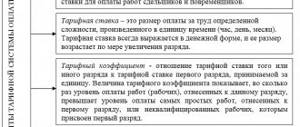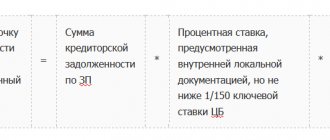Home / Labor Law / Payment and benefits / Wages
Back
Published: 03/03/2016
Reading time: 7 min
0
1675
One of the varieties of the tariff system of remuneration is piecework. It provides for the calculation of payment to an employee with a focus on accounting for his labor costs: the number of products produced, actions performed or services provided to the client.
- Features of piecework payment
- Advantages and disadvantages
- Options for piecework wages Simple
- Piece-bonus
- Piece-progressive
- Indirect piecework
- Chord payment system
Areas of application
This approach to remuneration is appropriate for an enterprise that produces a large volume of standard products (the emphasis is on the quantity of goods, and the degree of processing is easy to calculate).
SPOT has also found wide application in the field of sales (company managers strive to increase the organization’s profits if their earnings depend on it). At the same time, it is also implemented in other sectors of the economy, but much less frequently.
The choice of a piece-rate progressive approach to remuneration is explained by the specifics of the employer’s activities, who are interested in constantly increasing the productivity of each employee and at the same time do not seek to create new jobs.
In organizations that produce piece goods that are valuable for their uniqueness, the production of which requires a lot of time and, possibly, a creative approach is involved, the use of POTS does not make sense.
Outfit design
To record the amount of work performed, a work order is issued for the employee, and a time sheet is issued to record the time worked. Each employer draws up the work order himself, since there is no official form of the contract.
Some industries have already developed variants of orders, for example, waybills or contracts for piecework in agriculture.
Despite the lack of an official form, this document must take into account:
- characteristics of the work or services performed, description of the goods produced;
- the amount of time spent on producing goods (or performing work/services);
- required amount;
- prices;
- amount of time worked;
- amount paid including bonuses.
The work order is issued for each employee or team.
Construction of progressive piece rates
The local document of the company and (or) the employment contract establishes standards for the production of goods (performance of work), as well as the amount of payment for exceeding them. Systems for generating final wages may be as follows.
Single stage
| Number of goods produced, work performed, services provided | Unit of time (week, month, quarter) | Payment for a minimum of goods, works, services | At an increased rate for goods, works, services produced in excess of the norm |
| 100 pieces. | 1 month | 100 rub. for 1 piece | 130 rub. for 1 piece |
Two-stage
| Number of goods produced, work performed, services provided | Unit of time (week, month, quarter) | Payment for a minimum of goods, works, services | At an increased rate up to 50 pcs. goods, works, services produced in excess of the norm | At an increased rate for goods, works, services produced above the minimum + 50 pcs. |
| 100 pieces. | 1 month | 100 rub. for 1 piece | 130 rub. for 1 piece | 140 rub. for 1 piece |
Multistage
It is similar in structure to a two-stage one and differs only in the number of steps with an increase in the coefficient of payment for goods/work.
Salary calculation
The calculation uses an integrated approach.
At the first stage, the usual piecework part of the salary is calculated using the established general price per unit.
If the shift norm is exceeded, an additional calculation of bonuses is made for exceeding the plan.
For the calculation, special tables can be used, which clearly describe the conditions for a gradual increase in prices for the production of excess products (Table 2).
| Name of product | Standard price for 1 piece, rub. | Price for the first 10 pieces above the norm, rub. per piece | Price for the next 20 pieces above the norm |
| Blouse type A | 100 | 130 | 150 |
| Blouse type B | 120 | 140 | 160 |
| Shirt | 80 | 100 | 120 |
Important! In order for the ATP to fulfill its main stimulating function, it is necessary that the calculations are accessible, understandable to employees, and their results are strictly observed in the practice of paying wages.
Video with examples of piecework calculations:
Types and methods of counting
There are several methods (formulas) for calculating wages in organizations that use POTS.
The simplest method is suitable for calculations for small production volumes in companies using a single-stage system:
Z total. = Z psr + Z psr * K, where
Z total. – total salary amount, Z psr. – salary accrued at direct piece rates, K – increased payment coefficient.
The following formula was also created primarily for calculating earnings using a one-step approach to salary calculation:
Z total. = N total * K + N increase. * K1, where
Z total. – total salary, N total. – the general norm of production of goods (performance of work, provision of services), K – coefficient to the general norm of production, N increased. – increased labor standard, K1 – coefficient for the increased volume of work.
This method of calculating earnings is suitable for both two-stage and multi-stage wage systems:
Z total. = Z1 + Z2 + Z3 + Z..., where
Z total. – the total amount of salary, Z1 – an increased rate if the production rate of the first stage is exceeded, Z2 + Z3 + Z... – an increased rate for the production rate of the second, third and subsequent stages.
You can also use a more complex, but effective method in calculations, implemented mainly in enterprises engaged in the production of large volumes of the same type of goods (in factories, factories):
Z total. = Z sd. * (1 + ((N fact. - N min.) / N fact.) * K), where
Z total. – total salary, 3 days. – salary at minimum rates, N fact. – actual work performed, N min. – minimum production standards taken as a basis, K – increased price coefficient.
Calculation examples
Example 1. Assembler Petrov works at a piece rate of 50 rubles per 1 assembled product unit. Replacement rate is 30 knots. When the shift norm is exceeded by up to 10%, a progressive coefficient is set at 0.25, over 10% - 0.5. In fact, Petrov made 38 knots in one shift.
His daily earnings will be:
- At the piece rate 38 x 50 = 1,900 rubles.
- For exceeding the norm by up to 10% – 3 x 0.25 x 50 = 37.5 rubles.
- For exceeding the norm by more than 10% – 5 x 0.5 x 50 = 125 rubles.
- Total salary for the day is 1,900 + 37.5 + 125 = 2,062.5 rubles.
Example 2. Combine operator Vasiliev threshed 80 tons of wheat in a day when the norm was 30 tons. The standard piece rate is 60 rubles per 1 ton, the excess rate is 100 rubles per 1 ton.
His earnings are: 30 x 60 + 50 x 100 = 1,800 + 5,000 = 6,800 rubles.
Progress coefficients should be set in such a way as to most effectively satisfy the enterprise's needs for increasing the quantity of products (while maintaining good quality characteristics) and motivate workers.
Features of payroll
The piece-rate progressive method of payment is implemented in organizations both on an ongoing basis and as a measure to quickly increase the volume of work and units of production (in the case of adjusting production or monopolizing the market).
In such circumstances it is temporary. Since each company has its own specifics of work and features of the products manufactured, the forms of payment to employees also differ significantly.
Local acts of a legal entity (for example, the Regulations on remuneration) establish the most appropriate minimum production standards, taking into account all the circumstances, payment coefficients for increased volumes of labor, as well as the type of POTS (one-, two- or multi-stage).
The income level of an individual employee may be higher or equal to the average for the organization: everything depends on his work, which, of course, encourages him to fulfill and exceed the plan.
It is equally important for the employer to take into account that in the pursuit of increasing units of products produced (or services provided), their quality may decrease. Therefore, there is a need to develop measures to monitor the activities of employees (large enterprises create quality control departments, small legal entities or individual entrepreneurs must think through this procedure on their own).
A type of piecework payment is piecework-progressive wages, in which, as a rule, within the limits of meeting production standards, payment is made at normal piecework rates, and all products manufactured in excess of the norm are paid at increased rates on a special scale.
In the production of electronic devices, when production standards are met by an average of 110%, the piece rate for manufactured products in excess of fulfilling the norm from 110 to 115% can increase by 30%, when fulfilling over 115 to 125% - by 50%, over 125 to 140 - by 75% and over 140% the price increases by 100%. [p.208] Initial data. When manufacturing product A in a narrow workplace that limits the production output of the department, piece-rate progressive wages were introduced. The worker works in a 36-hour work week. The work belongs to the 3rd category of complexity. The scale option is given in table. 7.10 [p.242] With piece-rate progressive wages, products (work) produced within the established norm (base) are paid at basic piece rates, in excess of the established norm - at increased prices. [p.149]
Under a piece-rate progressive wage system, prices per unit of product (or work) produced by a worker in excess of the norm progressively increase. Piece-progressive wages in enterprises. oil refining is rarely used and always after a thorough economic justification. Otherwise, the application of this system may ultimately lead to wage growth rates being outpaced. labor productivity growth rates. [p.196]
In some cases, piecework-progressive wages are used, in which production in excess of the norm is paid at progressively increasing rates. This system cannot serve as a mass and constant form of remuneration, since under it the worker’s earnings can grow faster than the productivity of his labor. But in some cases, when, for example, it is necessary in the interests of the enterprise as a whole to urgently expand bottlenecks, piecework-progressive payment is used. [p.325]
Workers are notified two weeks in advance of the cancellation or change of the provision on piecework-progressive wages. [p.76]
Example. Let us assume that in the planned cost per unit of production of the enterprise, equal to 500 rubles, fixed overhead costs amount to 198 rubles, or 39.6% of the total cost. The basic salary for work that is expected to be transferred to progressive piecework payment is 39.6 rubles, or 7.92% of the total cost per unit of production. At the same time, 80% of the savings generated on fixed overhead costs due to exceeding the plan is already used to organize other incentive systems of remuneration (for example, bonuses for exceeding production plans). Consequently, only the remaining 20% of savings on constant overhead rates can be used to the maximum for organizing piecework-progressive wages. [p.120]
In some sectors of the national economy, piecework-progressive wages are used, according to which, for an increasing percentage of exceeding production standards, payment is also made at increasing (progressive) rates. One form of piecework payment is lump sum payment, which is widely used in construction and agriculture and is paid for completing a predetermined amount of work. [p.260]
A progressive increase in prices for piecework-progressive wages is carried out according to a special scale developed by the labor and wage department of the plant. [p.134]
The use of piece-rate progressive wages is very limited, since with such a payment system the worker’s earnings grow faster than the productivity of his labor. Therefore, it cannot become a mass and permanent form of payment. It is usually used temporarily and only in so-called narrow areas of production. [p.247]
Overspending of the wage fund is also caused by the predominance of experimental statistical norms and the unjustified use of bonuses and piece-rate progressive wages. Very often, the reason for overexpenditure of the planned wage fund is unproductive payments (payment for downtime, overtime hours, labor costs not provided for by technology due to the lack of necessary equipment, fixtures, changes in drawings, etc.). [p.241]
When organizing piecework-progressive wages, the correct recording of actual time worked and the volume of work performed is of great practical importance, since any distortion of these indicators leads to an incorrect determination of the percentage of fulfillment of the established initial norm (base) and gives rise to overpayments or shortchanges of workers' wages. [p.165]
Progressive additional payment is paid at the expense of the amount of adjustment to the planned wage fund in connection with overfulfillment of the production plan. Properly constructed piece-rate progressive wages should be accompanied by overfulfillment of the production plan and an increase in labor productivity. Therefore, it is necessary to check whether the amount of additional payments paid for progressive payment will correspond to the amount of the adjustment to the wage fund of workers who are transferred to progressive piecework. The check can be done using the formula [p.166]
With piece-rate progressive wages, wages are calculated for the planned quantity of production - at a direct piece rate, and for products in excess of the norm - at progressively increasing rates. [p.113]
Leadership arises where there is a need for proactive action, the fastest achievement of a goal and satisfaction of interest, that is, an urgent solution to a problem. This requires the interaction of a certain number of people who want the path to achieving goals not to be painful, but to be satisfying in itself. In this regard, two structures arise in the group, having different functional purposes. The first category of interests can be presented as a functional, instrumental structure. Here we are talking about the interest of each participant in achieving the goals of the group. Thus, in a production team working on the basis of piecework-progressive wages, each participant is interested in ensuring that the team produces more output and, therefore, that the earnings of each participant are correspondingly higher. These goals determine the functional structure, that is, the division of labor processes that ensures the greatest efficiency of the team. A person who is able to satisfy this need for optimal task distribution is promoted as a business (instrumental) leader. [p.77]
Varieties of forms of payment that take into account specific working conditions are payment systems. They are very diverse. Thus, some workers are paid according to a direct piece-rate system, in which payment is made at uniform rates, regardless of the degree to which the production norm is met. At the same time, in industry, 95% of piece workers, and in construction - about 40%, are paid according to the piecework-bonus system, which provides for the issuance of bonuses for a number of indicators. In some sectors of the national economy, piecework-progressive wages are used. Under this system, the worker's output within the established norm is paid at basic and constant rates, and above the initial level - at increased rates. [p.422]
Piece-progressive wages are being introduced temporarily in the most important areas of main production. Under this system, a worker’s earnings are determined for fulfilling production standards, as with direct piecework wages, i.e. at established prices. If the established norm is exceeded, additional payments to the basic piece rate increase progressively. Progressive additional payments are calculated [p.188]
Production team - 140. Foreman - 143. Auxiliary workers - 145. Salary—145. Collective piecework wages - 149. Labor participation coefficient (LPC) - 150. Personal savings account - 152. Personal (team) production plans of workers - 153. Material and moral incentives to work—155. Multi-machine service—157. Scientific organization of labor (SLO) - 159. Time standard - 161. The production rate is 163. Service standard - 165. The experimental-statistical norm is 165. The rate of consumption of material resources is 166. The technically justified rate is 167. Limitation of deductions from wages—168. Payment for downtime—169. Lump sum remuneration—169. Main workers—170. Occupational safety—171. Best practices—173. Revision of standards - 174. Time wages - 177. Incentives for saving fuel and energy - 178. Bonuses for workers—179. Labor productivity in the workplace—181. Working hours - 182. Overtime - 184. Piecework indirect wages - 185. Piece wages - 186. Piece-bonus wages—188. Piece-progressive wages—188. Production crew advice -189. Combination of professions—190. Tariff scale—191. Tariff system - 193. Tariff rate - 194. Tariff and qualification reference book—> 195. Safety precautions—197. Working day photo—198. Timing - 201. [p.239]
Piece-progressive wages. They are used to materially reward piece workers for products produced in excess of the established norm. For products produced within the standard, workers are paid at direct piece rates, and above the standard - at progressively increasing rates. [p.120]
Piece-progressive wages are practically not used in agricultural enterprises. [p.277]
Piece-progressive wages are remuneration for labor at piece rates within the established norm, and for performing work above the norm - at progressively increasing piece rates. Such wages can be introduced for a limited period in those industries where additional measures are required to stimulate labor intensity in order to achieve progressive production standards. Under a progressive piece-rate system, a worker's earnings grow faster than his output. [p.190]
PIECE-PROGRESSIVE WAGES - [p.476]
Piece-progressive wages [p.129]
Rate is the amount of labor remuneration per unit of work. R. are used for piecework wages. Their value depends on the production rate and tariff rate. With piecework-progressive wages, work performed in excess [p.117]
Rate is the amount of labor remuneration per unit of work. R. are used for piecework wages. Their value depends on the production rate and tariff rate. With piecework-progressive wages, work performed in excess of the norm is paid at increased rates. [p.148]
In production areas where piecework-progressive wages are applied, and bonuses are paid for meeting and exceeding production standards, accounting for the fulfillment of standards is carried out in accordance with paragraphs 43 and 44 of these provisions. [p.291]
A worker’s earnings with piecework-progressive wages of Zsl are determined depending on the adopted progressive payment system (for the entire volume or for part of the volume of work performed in excess of the norm) according to one of the following formulas [p.552]
When using piece-rate progressive remuneration, special attention should be paid to determining the normative baseline, developing effective scales for increasing prices, accounting for production output and actual time worked. [p.553]
With individual piece-rate progressive wages (Zsd prog) [p.72]
Calculate the monthly wage of a worker with piecework-progressive wages. A worker of the 1st category is engaged in hazardous work. The hourly production rate is 50 parts. 168 hours were worked per month, the actual output for the month and the type of work are given in the table. 5.5. [p.80]
EXAMPLE Let's use the conditions of the previous example. However, let’s assume that the organization has established piecework-progressive wages. [p.493]
Piece-progressive wages are usually introduced in critical areas that are a “bottleneck”, with a special need for material incentives for workers to increase output. Under this system, the worker’s earnings for fulfilling the production quota are determined as with direct piecework payment. If the established norm is exceeded, additional payments to the basic piece rate increase progressively. Progressive additional payments are awarded based on the results of monthly work. When calculating wages, only high-quality products are taken into account. [p.109]
With piece-rate progressive wages, wages (Zs p og) are calculated according to the formula [p.109]
In order to create greater interest in the results of labor, piece-bonus and piece-progressive payment are used. With a piecework-bonus system, a worker’s earnings consist of payment for the quantity of products produced at established, constant prices and bonuses for improving quantitative or qualitative indicators. Under the piece-rate-progressive system, the worker’s output within the limits of the initial norm is paid at direct piece rates, and in excess of the established norm - at increased, progressive rates. The progressive piecework system is used in the most critical areas of production. The permissible increase in wages is determined by the savings from reducing production costs with an increase in production volume. [p.87]
With a piece-rate bonus system, in addition to payment at piece rates, a bonus is paid for achieving certain quantitative and qualitative results. The piece-rate progressive wage system provides for additional incentives for piece workers for products produced in excess of the established norm or its initial base. Products produced within the norm are paid at constant piece rates, and products produced in excess of the norm are paid at progressively increasing prices. The use of piecework-progressive wages complicates the calculation of wages and often (when using high scales of additional payments for overperformance)
Under a piece-rate progressive wage system, prices per unit of product (or work) produced by a worker in excess of the norm progressively increase. Piece-progressive wages at oil and gas processing enterprises are rarely used and always after a thorough economic justification. The danger of widespread implementation of this system is that, by progressively increasing the amount of earnings per unit of output, it may ultimately lead to wage growth rates that are faster than the growth rates of labor productivity. [p.152]
Along with direct piecework wages, in many cases piecework-progressive wages are used, which consists in the fact that each unit of work performed by a worker in excess of the established norm is paid at a higher rate than within the norm. Piece-progressive payment, to a much greater extent than direct piece-rate payment, stimulates an increase in labor productivity. By reducing the share of so-called disproportionate costs per unit of work (product), savings are obtained, part of which serves as a source for the payment of progressively increasing premiums to piece rates. Payment according to the piece-rate progressive system is made based on the results of the worker’s monthly work, taking into account the general increase in labor productivity. [p.134]
Allow republican ministries and departments to transfer certain categories of workers to a piece-rate-progressive system and, in agreement with the All-Union Central Council of Trade Unions, to a time-bonus wage system in relation to the systems and wage scales existing in the relevant industries, while maintaining a preferential position for workers in leading industries and construction in the form increased rates of piecework-progressive wages approved for them. [p.95]
In production areas where quality, processing accuracy or other indicators of work quality are of particular importance, instead of bonuses for fulfilling and exceeding production plans, as well as piece-rate progressive wages, bonuses are introduced for improving product quality or improving other indicators of work quality 1. When In this case, the bonus (as a percentage of the tariff rate) should not exceed the maximum amount of bonuses established for a given group (profession) of workers in the relevant industry for fulfilling and exceeding the plan. Payment of these bonuses must be made subject to the fulfillment of the production plan by the unit, team, site or workshop, and where. Planned targets are not set, subject to the fulfillment of production standards for the month. [p.161]
PIECE FORM OF WAGES - a form of remuneration in which wages are calculated based on the use of piece rates established per unit. work performed or products manufactured (expressed in production operations, pieces, kilograms, cubic meters, team kits, etc.). By object of accrual S.f.o.t. can be collective and individual. According to the accrual method, it is divided into direct, piece-rate, indirect, piece-rate, and piece-progressive systems. [p.317]
Remuneration for non-compliance with standards
It is worth remembering that piece-rate progressive wages are best used only in circumstances where there is no likelihood of production downtime due to the fault of the employer. Indeed, in this case, by virtue of Art. 155 of the Labor Code of the Russian Federation, an employee is paid an amount not less than the average monthly salary.
If the employee himself is to blame for failure to comply with production standards, payment is made for the volume of goods actually produced.
Payment in the amount of at least two-thirds of the established production standards is made if there are reasons beyond the control of the parties to the employment contract.
According to the provisions of Article 156 of the Labor Code of the Russian Federation, complete defects that occur through the fault of the employee are not subject to payment. In the absence of his fault, the goods are evaluated along with suitable products. If the product is partially defective, and the contractor’s fault is proven, the amount of money is calculated at reduced prices based on the degree of suitability of the product.
How is piecework wages calculated?
From the name of the term it becomes clear that we are talking about material goods made / produced by the employee. In a simpler form, the term is explained as follows: as much as you did, so much you received. And such legal relations do not contradict current labor legislation. Article 150 of the Labor Code of the Russian Federation directly mentions this form of wage calculation.
Piece wages are used when the result of the employee’s professional activity has some kind of material expression. This form is quite often used in production. For example, an employee of a confectionery shop can make 50 cakes on one day, and 150 on another day. With such a difference in results, it makes no sense to assign the employee a constant salary.
The reason for this decision is simple. Today the employee does not fulfill the plan, but tomorrow he exceeds it. The employer will have to constantly monitor the work of its employees so that they do not deviate too much from production standards. With piecework payment there are no such problems. The employer just needs to count the number of cakes that each employee of the workshop made per day and add up the daily total for each of them.
Summarizing
The piece-rate progressive wage system is convenient for both parties to the employment contract. Employees are interested in exceeding the established minimum amount of work; depending on exceeding the plan, salaries can increase significantly.
The employer pursues his own benefit: there is no need to create additional jobs, employ and train new people who are not interested in increasing the quantity of products produced, and pay them a fixed salary.
At the same time, the piece-rate progressive form of remuneration is not yet widely used in the market, which is caused by some complexity in calculations, and is also associated with the risk of deterioration in product quality.
Registration of piecework wages in 1C is presented in the video below.
Basic prices
Let's consider the question of how to correctly calculate piecework wages and prices for it. The piece rate can be calculated by a rater based on an analysis of the work of an employee or the team as a whole over several months.
The instructions for calculating the piece rate are as follows:
- Conduct a performance analysis for three, six and twelve months. To do this, all products produced during the analysis period are added up and divided by the number of working days in the billing period. This gives the average of the products produced per day. The resulting value must also be divided by the number of working hours, to obtain the number of products produced per hour.
- We provide pricing for manufactured products. To do this, we determine the average daily salary of an employee. To make this calculation, we add up all the employee’s earnings for 12 months, divide them by 12 and by 29.4 (the average number of working days in a month). We get paid in one day.
- Let's divide the average daily wage by the number of products produced by a worker in one day. We get the cost of one part.
- To determine average piece rates, we add up the number of products produced for three, six, twelve months of all employees and divide by the number of days during which the products were produced.
- We calculate average earnings for the analysis period.
- We divide the average daily salary by the number of products produced per day. We thus obtain the average piece rate.
Piece payment agreement
Any employment relationship is secured by a documentary agreement. With an open-ended contract, a standard employment contract is concluded, which specifies the option for calculating and calculating wages. This condition must be specified as a separate clause.
In temporary labor relations, a fixed-term contract with the employee or a civil law contract is concluded. The performance of one-time work is accompanied by the conclusion of a GPC agreement. In each of these cases, the employer notifies the potential employee that their wages will be calculated on a piece-rate basis.
The potential employee has the right to agree or disagree to such a condition. But the payroll calculation form cannot be hidden from him in any way. In this case, piecework payment may imply on the day:
- Minimum and maximum output.
- Specific scope of work.
- Absence of any installations and standards.
These indicators can be established in relation to one employee or in relation to a team (team) of workers. In the first case, the fruits of labor activity are calculated in relation to one employee, who receives payment for his individual merits. The second scheme - the results of professional activity are calculated in relation to a team of workers.
Payment is made in one tranche to the responsible person, who then pays each worker their due wages. This scheme is widely used on construction sites. The customer evaluates the work of the team of workers, and then pays for their work in accordance with the previously reached agreement.









